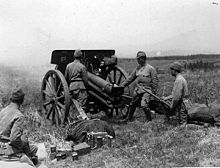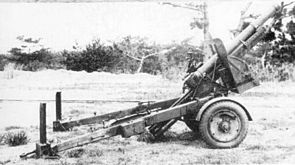Type 91 10 cm howitzer
| Type 91 10 cm howitzer | |
|---|---|
|
|
|
| General Information | |
| Military designation: | 九 一 式 十 糎 榴 弾 砲 |
| Manufacturer country: |
|
| Developer / Manufacturer: | Arsenal Osaka |
| Development year: | 1931 |
| Production time: | 1931 to 1945 |
| Weapon Category: | howitzer |
| Technical specifications | |
| Pipe length: | 2.54 m |
| Caliber : |
105 mm |
| Caliber length : | L24 |
| Weight ready for use: | 1500 kg |
| Elevation range: | -5 to +45 degrees |
| Side straightening area: | 40 ° |
| Furnishing | |
| Closure Type : | Screw lock |
| Ammunition supply: | individually |
The Type 91 10-cm howitzer ( Japanese 九 一 式 十 糎 榴 弾 砲 , Kyūichi-shiki jūssenchi ryūdanhō ) was a howitzer used by the Imperial Japanese Army in the Second Sino-Japanese War and during the Pacific War from 1931 to 1945 . The designation Type 91 indicates the year the troops were introduced, the year Kōki 2591 or 1931 according to the Gregorian calendar.
history

The Type 91 10cm Howitzer was introduced into the Imperial Japanese Army in 1931 as a lightweight, modern gun . Equipped with a hydropneumatic recoil mechanism , a spreading carriage and an interrupted screw lock , the howitzer could shoot projectiles weighing more than 15 kg over 10 km. With a relatively high production number of 1200 pieces for Japanese guns at the time, it became one of the most widely used howitzers in the Imperial Japanese Army and, in addition to the 75 mm field gun Type 90, was used in many artillery regiments subordinate to the Army divisions .
Calls

During the Japanese invasion of the Philippines , the American and Filipino defenders had retreated to the Bataan Peninsula . After the first Japanese attack was repulsed, General Homma Masaharu sent strong artillery forces under Major General Kitajima Kineeo to crush the Allied forces. Among the 190 Japanese guns with calibers between 75 and 240 mm were eight Type 91 howitzers of the 4th Field Gun Regiment. The Type 91 fired 2,908 shells. After six hours of bombardment, the advancing infantry were able to take the peninsula without major resistance.
During the Battle of Guadalcanal four Type 91 howitzers of the 2nd Field Gun Regiment were used, but were only used to a limited extent due to a lack of supplies.
When defending Saipan , the Japanese defenders owned fourteen Type 91 howitzers belonging to the Artillery Unit of the 47th Independent Mixed Brigade . Although the howitzers in particular took the American landing under heavy fire, the US Marines were able to bring their own guns ashore and use them to take out half of the Japanese guns by the end of the first day. On the second day of the landing, the rest of the Japanese guns were also destroyed.
The Japanese army had eight fortresses built along the border with the Soviet Union, of which the Kotō fortress on the Ussuri River was the strongest. Large-scale fortifications, similar to the Maginot Line , were guarded by the 4th Border Guard Unit. The 1400-strong crew had two batteries of field guns and type 91 howitzers, the type 90-240 mm railway gun and the experimental 41 cm howitzer . When the Soviets attacked the Japanese positions around the Kotō fortress in August 1945 in Operation Auguststurm , the entire fortress garrison was destroyed and all artillery was lost.
The Type 91 remained in service with the Imperial Japanese Army until the end of the Pacific War.
After Japanese troops left mainland China after Japan surrendered, the abandoned Type 91s were used by the National Revolutionary Army and the People's Liberation Army during the Chinese Civil War .
Technical specifications

The Type 91 howitzer was relatively light compared to similar 105mm howitzers of the time. Although the Japanese name of the howitzer speaks of 10 cm , the caliber is 105 mm. About 1,100 copies were fitted with wooden spoke wheels and were normally pulled by six horses. Elevation and rudder handwheels and the aiming mechanism were to the left of the gun barrel . The fire mechanism was operated with the help of a lanyard. The rate of fire was six to eight rounds per minute. In addition to the version with the wooden wheels, a so-called motorized version with rubber tires was also used, of which around 100 were produced.
- Caliber: 105 mm
- Caliber length: L / 24
- Pipe length: 2.54 m
- Elevation range: −5 ° to + 45 °
- Side straightening range: 40 °
- Gun weight: 1,500 kg
- Bullet weight: 15.7 kg
- Muzzle velocity V 0 = 546 m / s
- Maximum range: 10,800 m
- Number of items produced:
- Wooden wheels version: 1.100
- Tire version: 100
literature
- Gordon L. Rottman : "Japanese Army in World War II 1941-42" Osprey Publishing, 2005, ISBN 978-1-84176-789-5 .
- Chris Bishop, "The Encyclopedia of Weapons of WWII: The Comprehensive Guide to Over 1,500 Weapons Systems, Including Tanks, Small Arms, Warplanes, Artillery, Ships" MetroBooks (NY), 2002, ISBN 978-1-58663-762-0 .
Web links
- Type 91 10cm Howitzer. Taki's homepage, accessed November 20, 2015 .
- Japanese Artillery Weapons, CINPAC-CINPOA Bulletin 152 45th US War Department, accessed November 20, 2015 .
- Chapter d. Model 91 (1931) 105-mm gun. Handbook on Japanese Military Forces, September 1944, accessed December 22, 2014 .
Individual evidence
- ↑ a b Type 91 10cm Howitzer. Taki's homepage, accessed November 20, 2015 .
- ↑ Chapter d. Model 91 (1931) 105-mm gun. Handbook on Japanese Military Forces, September 1944, accessed December 22, 2014 .
- ↑ a b c d The history of battles of Imperial Japanese Artillery Forces. Taki's homepage, accessed March 12, 2015 .
- ↑ a b Japanese Artillery Weapons, CINPAC-CINPOA Bulletin 152 45th US War Department, accessed November 20, 2015 .
